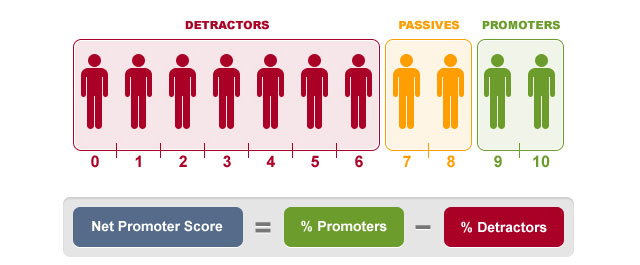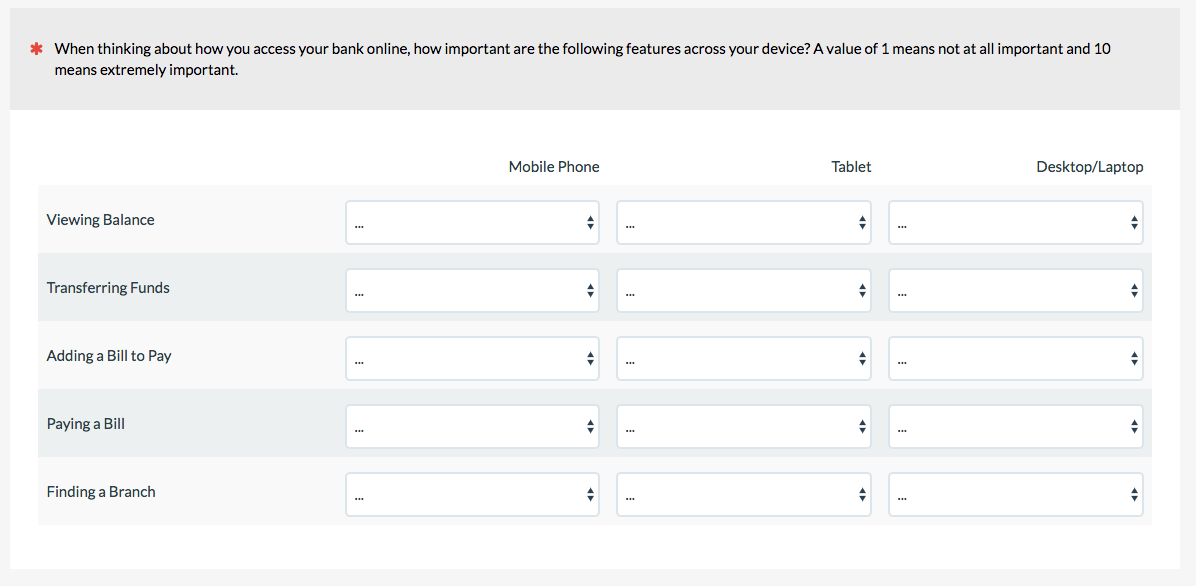39 survey rating scale labels
› science › articleHow to analyze Likert and other rating scale data - ScienceDirect Nov 01, 2015 · When anchors or labels are only provided at the extremes, these can be called numerical rating scales (Fig. 1B). Fully anchored rating scales represent the situation when an anchor is provided for each numerical option (Fig. 1C). An individual Likert item could be viewed as a specific instance of a fully anchored rating scale where the anchors ... How to Label Response Scale Points in Your Survey - Qualtrics Finally, to ensure that you get the highest-quality data possible, keep these four guidelines in mind as you practice labeling response scales: Ensure each scale point is verbally labeled; Use response options that correspond to the subject of the question; Use consistent language across the entire response scale; Use balanced scales
Which Rating Scales Should I Use? - Relevant Insights Semantic Differential Scale: A 7-point rating scale with endpoints associated with bipolar labels that have semantic meaning (e.g., bipolar adjectives like "friendly" and "unfriendly"). Variations of the Likert and Semantic Differential scales abound.

Survey rating scale labels
Rating and Ranking Levels of Satisfaction in Your Survey A possible scale is then: "Not at all Satisfied," "Partly Satisfied," "Satisfied," "More than Satisfied," "Very Satisfied," numbering 1 to 5 as an interval scale. Rather than a Very Good to Very Poor rating, this set of rating scale survey questions looks at levels of satisfaction. Rating Scale: Definition, Survey Question Types and Examples Rating Scale Definition Rating scale is defined as a closed-ended survey questionused to represent respondent feedback in a comparative form for specific particular features/products/services. It is one of the most established question types for online and offline surveys where survey respondents are expected to rate an attribute or feature. waypointgroup.org › why-a-0-10-scale-is-your-bestStop Debating the Survey Question Scale: Why a 0-10 Scale is ... Jan 10, 2017 · Using a 5-pt scale, scores tend to cluster around 3 and 4 (and there’s a huge difference in most peoples’ minds between a 3 and 4 on a 5-pt scale) so it’s difficult to discern the true drivers. In the customer’s mind, there’s a difference between a rating of 6 and a rating of 7 (for example) that you can’t capture on a 5-pt scale.
Survey rating scale labels. Choice of rating scale labels: implication for minimizing patient ... Loading the rating scale with more positive labels appears to be a useful strategy for reducing the ceiling effect and increases the discrimination ability of survey responses. Conclusions: The current research provides a survey design strategy to minimize ceiling effects. 15 Common Rating Scales Explained - MeasuringU Here are 15 scales, in roughly the order of most to least commonly used. 1. Linear Numeric Scale In a linear numeric scale, participants provide some numeric response to a question or statement. This can include things like satisfaction, ease, brand favorability, feature importance, or likelihood to recommend. kwiksurveys.com › blog › survey-design12 Tips for Writing Survey Answers - KwikSurveys Likert scale questions: Numbered scales are used to find out how respondents feel about a question or statement (e.g. ‘Not at all likely to recommend’ to ‘Very likely to recommend’). Rating questions: Ratings can come in many forms, from star ratings to emoticons (e.g. smiley faces, thumbs, or hearts). Demographic survey questions: Analyzing and Interpreting Data From Rating Scales - Medium Rating Scales are an effective and popular way to gauge attitudes and opinions. They are easy to implement and widely used in surveys, feedback forms, and performance evaluations. Yet, misuses and mistakes often occur in the implementation and analysis of this seemingly intuitive tool. The ability to understand and synthesize information from ...
How to Add a Rating Scale Grid Question to Your Survey - sogosurvey.com To add a question to your survey, drag and drop the question type from the panel on the left to the correct spot on the right. You may choose to enter anchor text for the scale in the Lowest, Middle, and Highest fields, then assign a numeric weight for each level. In reports, you'll see both the frequency with which each answer option was ... Satisfaction Surveys and Questionnaire Rating Scales - Snap Surveys Blog 2. What measurement scale to use: Level of Satisfaction How well the product or service meets expectations How good or bad the product or service is Level of Importance 3. The number of points on the scale 4. Balanced and unbalanced scales 5. The labels for points on the scale 6. Handling "Don't Knows" 7. How to word the question in an unbiased way Survey Scale: Definitions, Types + [Question Examples] - Formpl A rating scale is a type of survey response scale that allows respondents to match specific qualitative values with different assertions, products, or features. With a rating scale, you simply answer the survey question by picking one of the rating options on the scale. A rating scale can be categorized as ordinal or interva l. cxl.com › blog › survey-response-scalesSurvey Response Scales: How to Choose the Right One - CXL Survey response scales can be embedded in the survey (e.g., 1-5, 1-10, etc.), chosen via a drop-down menu, or included as part of the survey language. No matter how you choose to display the scale, the default ranges affect the precision of your data. For example, if a survey asks your age, a default range of 20-25 instead of 20-30 has ...
Survey rating scales 1-5: Understand your audience better Businesses use survey rating scales to gather information about satisfaction levels, frequency of use, loyalty, and other customer data. Rating scales allow you to compare customer response data to determine which of your products and services are most effective. This data is essential for making informed business decisions across all departments. › blog › rating-scaleWhat is a Survey Rating Scale? + [Types & Question Examples] A numerical rating scale is typically used to quantify qualitative data such as pain, feelings, product satisfaction, likelihood to recommend, customer loyalty and the like. Usually, the researcher labels the endpoints of the numerical rating scale in terms of the value that is being measured so that both ends represent the extremes of this value. Should All Scale Points Be Labeled? - MeasuringU One core question about multipoint rating scales is whether to label all points or just the endpoints. ... (2007) conducted two studies that varied the style of rating scales in a web-based survey with over 5,000 U.S.-based panel respondents answering 16 seven-point items, including seven dietary habits items with endpoints of "Strongly ... › blog › three-tips-forYour Guide to Rating Scale Questions in 2022 - Qualtrics What is a rating scale? A rating scale is a type of survey question that uses closed questions, when gaining information from a respondent. ... In practice, this means the response options for a satisfaction question your Likert scale labels should look like this: If you're dealing with an idea or construct that ranges from zero to positive ...
waypointgroup.org › why-a-0-10-scale-is-your-bestStop Debating the Survey Question Scale: Why a 0-10 Scale is ... Jan 10, 2017 · Using a 5-pt scale, scores tend to cluster around 3 and 4 (and there’s a huge difference in most peoples’ minds between a 3 and 4 on a 5-pt scale) so it’s difficult to discern the true drivers. In the customer’s mind, there’s a difference between a rating of 6 and a rating of 7 (for example) that you can’t capture on a 5-pt scale.
Rating Scale: Definition, Survey Question Types and Examples Rating Scale Definition Rating scale is defined as a closed-ended survey questionused to represent respondent feedback in a comparative form for specific particular features/products/services. It is one of the most established question types for online and offline surveys where survey respondents are expected to rate an attribute or feature.
Rating and Ranking Levels of Satisfaction in Your Survey A possible scale is then: "Not at all Satisfied," "Partly Satisfied," "Satisfied," "More than Satisfied," "Very Satisfied," numbering 1 to 5 as an interval scale. Rather than a Very Good to Very Poor rating, this set of rating scale survey questions looks at levels of satisfaction.










Post a Comment for "39 survey rating scale labels"